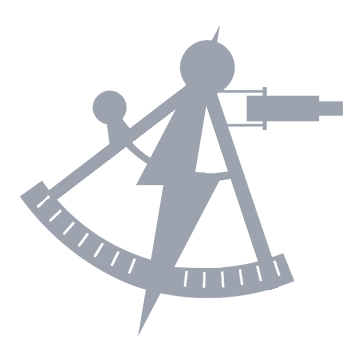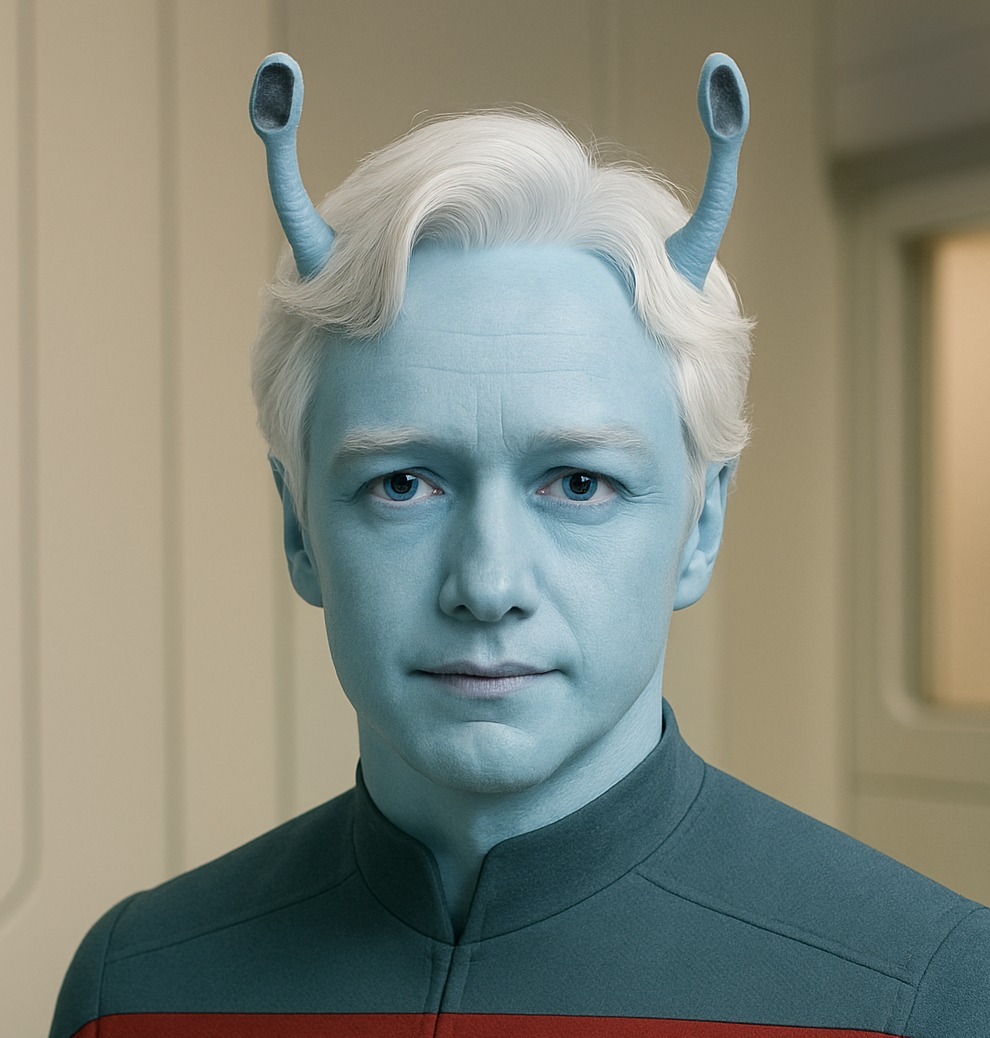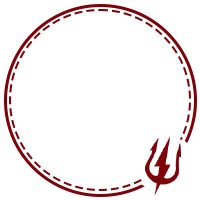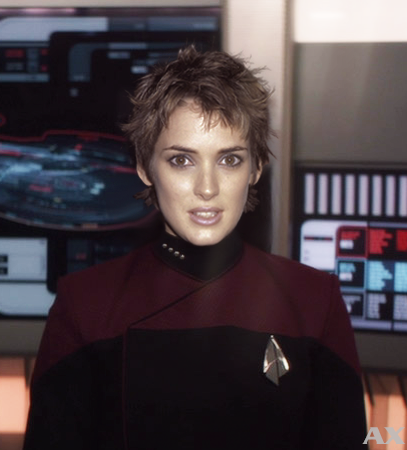The shuttle sliced through the layers of Palrilles IV’s atmosphere, a streak of white fire against the planet’s muted green sky. The turbulence was mild, but the air had a strange, oily shimmer that made the horizon ripple like water.
In the forward seats, Lieutenant Commander Craig Cruikshank and Lieutenant Junior Grade T’Luni worked in quiet synchronization, adjusting sensor gain and stabilizing the descent vector. Behind them, Lieutenant Junior Grade Tanna Irovin stared out the viewport, unable to tear her eyes away from the landscape unfolding below.
It wasn’t anything like she had expected.
From orbit, the basin looked like a simple geological depression. From here, it felt more like a wound – a vast, sunken scar ringed by jagged ridges and deep fissures that shimmered faintly in the diffused light.
“The uppermost caverns should be near those darker fault lines on the western slope,” Cruikshank said, checking his readouts. “Subsurface scans show the first opening roughly twenty meters below the rim. That’s where we’ll start.”
T’Luni nodded. “Sensor readings are consistent with our orbital data. Atmospheric density increases at the basin floor – possibly due to thermal inversion.”
Irovin leaned her head in between their seats. “And the reflectivity down there?”
T’Luni tapped the console. “Possibly crystalline deposits. Possibly… something else.”
Cruikshank gave a faint, almost self-conscious smile. “We’ll find out soon enough. I’m taking us in.”
The shuttle dipped lower. Outside, the mist thickened, curling like smoke around the cliff peaks. For a moment, the external lights caught something – not rock or vegetation, but smooth surfaces cut at right angles and faintly geometric depressions.
Irovin frowned. “Did you see that?”
Cruikshank nodded. “Yeah. The scans say this basin was carved by glacial erosion, but that didn’t look natural.”
“Many ancient civilizations shaped caverns for habitation,” T’Luni said evenly, “However, the architectural geometry here predates the surface weathering by several millennia.”
Irovin’s grin returned. “So… someone built this.”
“Someone,” the Lieutenant Commander echoed quietly.
The shuttle broke through the mist and leveled out above a narrow shelf of stone overlooking the basin. The landing struts touched down with a hiss. For a long moment, no one spoke. Outside, the wind carried a low, steady hum that didn’t sound quite natural, like the planet itself was exhaling.
Cruikshank pushed his glasses up his nose, then unbuckled from the seat and rose. “All right, people. Standard away team procedure. Irovin, you’re on geology and terrain mapping. T’Luni, environmental and sensor telemetry. Let’s see what’s out there.”
Irovin slung her backpack over one shoulder, feeling the excitement bubbling up again, and she fought to tamp it back down. “This could be the first record of intelligent life in this area of the Expanse,” she said, failing to hide her grin.
Cruikshank gave her a sidelong glance as the airlock cycled open. “Let’s hope, if we do meet anybody, they’re friendly.”
The hatch dropped open with a hiss, and the away team stepped out into the thin, cool air. The external lights from the shuttle pushed back the mist in sluggish, reluctant waves, revealing a barren terrace of grey stone overlooking the basin.
Even through her environmental suit, Irovin could smell it – the sterile, mineral tang of a planet that had been untouched for countless years.
“Radiation is nominal,” T’Luni reported with her tricorder. “Gravity is consistent with a standard Class-M. Atmospheric particulates contain traces of silica and oxidized metal.”
Cruikshank nodded absently, his eyes fixed on the far side of the landing shelf. “There,” he said quietly, pointing a finger.
Built into the cliff face, half-shrouded in veils of fog, was a pair of doors. Two huge, monolithic slabs of shiny black stone rising nearly twenty meters high. Time and weather had softened their edges, but not the reliefs cut into them.
A towering figure dominated the center – humanoid but distorted, its proportions elongated and its eyes carved as deep, swirling pits. Around its feet, rows of smaller figures knelt in reverence, their arms raised towards it in gestures of supplication.
The floodlights caught the faint gleam of mineral veins tracing through the carvings, like veins of gold or copper, though they pulsed faintly with an almost organic sheen.
Irovin took an involuntary step closer. “That’s… incredible,” she whispered, “Look at the detail. These lines, these grooves…”
The team stood in silence before the ancient doors for a long moment. The wind sighed again through the rocks of the cliff face, swirling mist across the ground. Irovin swept her tricorder across the carvings in slow arcs.
“The stone’s composition is mostly silicate and carbonates, but there is an internal crystalline structure that’s irregular. It’s almost like it’s been engineered.”
“Engineered how?” Cruikshank asked.
She tilted her tricorder slightly. “Well, the structure looks like it’s capable of transmitting energy, but there’s no connection to an external power source.”
“Like a circuit?”
“Basically, but it’s got a fractal pattern that repeats at a molecular scale.” She let out a low whistle. “Someone went through a lot of trouble just to carve a door.”
“Unless it was to keep something in,” Cruikshank said softly.
Irovin shot him a grin. “Comforting, sir.”
He ignored the jab, crouching to examine the lowest set of reliefs. The human figures were deeply worn, almost smooth by time, yet here and there the original artistry remained. Elongated fingers, eyeless faces, and spiraling symbols etched into their foreheads.
“Hard to tell what’s stylized and what’s anatomical,” he said, “the carving is too degraded.”
“They may have used tools beyond simple chisel work,” T’Luni noted. “The striation pattern is inconsistent with known primitive methods.”
Irovin’s curiosity got the better of her. She moved closer, reaching out a gloved hand toward the stone. “Maybe if I –”
“Lieutenant, don’t – ” Cruikshank started, but it was too late.
Her fingertips brushed the cold, hard surface of the doors.
For a heartbeat, nothing happened. Then, deep within the cliff, something shifted. A low, resonant groan that vibrated up through the stone beneath their boots. The veins along the deity’s carved figure flared faintly, threads of pale green light crawling through the channels like liquid fire.
Irovin stumbled back. “I didn’t do anything!”
“Tricorder’s spiking,” T’Luni said, stepping beside her. “Localized electromagnetic surge, rising fast.”
The air thickened, and it seemed to drop several degrees in seconds. Then came a sound, not natural or mechanical, but an ancient, grinding roar as the massive stone doors began to move.
Dust cascaded down on the away team in sheets. The surface split along a seam so fine that it had almost been invisible, the monolithic slab parting slowly inward. From the widening gap spilled a breath of cold air that smelled of iron and rain, and something vaguely sweet – like decaying flowers.
Cruikshank steadied himself, his voice tight. “Alright, no one touch anything else.”
For several long moments, the only sound was the low rumble of stone settling back into stillness. The great doors stood half-open now, revealing a yawning corridor of smooth walls and angles – too precise to be natural – descending into darkness.
The Lieutenant Commander exhaled slowly, forcing the tension from his shoulders. “T’Luni, get a transmission to the Erikson. They’re gonna want to hear about this.”
She nodded, stepping aside to open a channel. “Away Team to Leif Erikson,” she said calmly, “We have located the primary entrance to the subsurface structure. The outer doors have been opened – apparently in response to tactile contact. I have detected no external mechanisms.”
Captain Bowman’s voice came back, a little faint through the static of atmospheric distortion. “Acknowledged, Lieutenant. Proceed with caution, and maintain a live telemetry link.”
T’Luni’s PADD chirped softly. “Telemetry lock established.”
“All right,” Cruikshank said, tightening the straps on his field harness, “Let’s take a look.”
The three officers stepped closer to the threshold. The cool air that bled from the passage was stiller than the air outside, as if it were holding its breath, even listening. Their suit lamps cut long beams into the darkness, revealing walls that contained more reliefs of tall, slender figures in various states of awe and terror, always surrounding the same central deity.
Irovin lingered a moment before stepping inside. “Feels weird,” she muttered, “Like it’s… waiting for us.”
“Then we’d better not keep it,” Cruikshank said.
Together they crossed the threshold. Instantly, light bloomed above them. It wasn’t artificial, like a lamp or a panel, but a shaft cut clean through the stone high overhead, admitting into the tunnel a perfect column of sunlight. The beam fell directly across their path, illuminating motes of dust floating in the air like drifting stars.
Cruikshank looked between the two Lieutenants. “That wasn’t open before, was it?”
T’Luni adjusted her tricorder. “Negative. That shaft was sealed during our preliminary scans.”
“Maybe a pressure change?”
“Unlikely,” she said, her voice low, “That shaft opened as we entered. It is more probable that it was triggered by tactile contact, like the door.”
Irovin stepped forward cautiously, the soles of her boots crunching faintly against the ancient dust. When she moved beneath the column of light, the change was immediate. The cool, still air of the tunnel gave way to a brilliant warmth, as though a summer sun was shining down on her. She froze, half in wonder, half in alarm. “It’s bright. Brighter than it should be. Like I’m standing under the noon sun.”
“According to this,” Cruikshank said, glancing at his tricorder, “This shaft is over twenty meters deep. There’s no reason the light should be this concentrated.”
T’Luni followed, standing just shy of the beam’s edge. Her voice was quiet, almost reverent. “Fascinating. The alignment is precise to within a fraction of a degree. The structure must have been designed to automatically track the sun’s position.”
The team moved in silence after that, every footfall echoing with a strange clarity. The tunnel sloped gently downward, its smooth walls suggesting tools of incredible precision, or no tools at all. They had walked about fifty meters, almost out of the first shaft’s residual glow, when a second shaft snapped open, revealing another shaft of light with the same impossible brilliance. Unwavering, golden, and warm against the cold air. When the Lieutenant Commander checked his tricorder, the readings made no sense.
“No energy output. No heat source. Just light,” he muttered.
Irovin stepped carefully through the second beam, her shadow dissolving beneath her feet. “It’s like the sun’s following us underground,” she said, her voice hushed as if to avoid disturbing something.
T’Luni tilted her head, scanning the air with her tricorder. “The angle of incidence matches the previous aperture precisely. Yet we are now forty meters below the surface. Even if the shafts connect to the sky above, the shaft alignment defies geometric consistency.”
“English, please, Lieutenant?” Cruikshank said dryly.
She looked at him, her expression perfectly composed. “This light should not be here.”
They continued deeper, the air growing thinner and colder as they went. The beams became the only illumination, having left the entrance far behind them. Eventually, the tunnel slope started to even out under their boots.
Cruikshank raised a hand. “Hold up.”
Ahead, the passage terminated in a vast archway that swallowed the beams of light from their suit lights. The walls around it were adorned with reliefs that seemed to shift and move under the sweep of their lamps – rows of figures kneeling before a towering, faceless shape.
Irovin swallowed audibly. “Looks like a temple.”
T’Luni moved closer, her tricorder emitting a soft pulse. “No detectable energy emissions, but this chamber appears to be quite large. The far edge is outside the tricorder’s sensor range. There appear to be several tunnels that branch off from this room, all sealed.”
Cruikshank approached the threshold, running a gloved hand along the edge of the arch. The black stone was smooth – almost glassy. “Someone took a lot of time to build this place.”
He stepped through the archway, and the vast, dark chamber beyond breathed. A sudden current of warm air, seemingly from nowhere, breezed past them, causing the ancient dust to lift and swirl around their boots.
A low tremor rippled through the floor. From high above, a new shaft of light flared open, flooding the room with its blinding radiance. As their eyes adjusted, the scale of the place became clear.

 Bravo Fleet
Bravo Fleet










